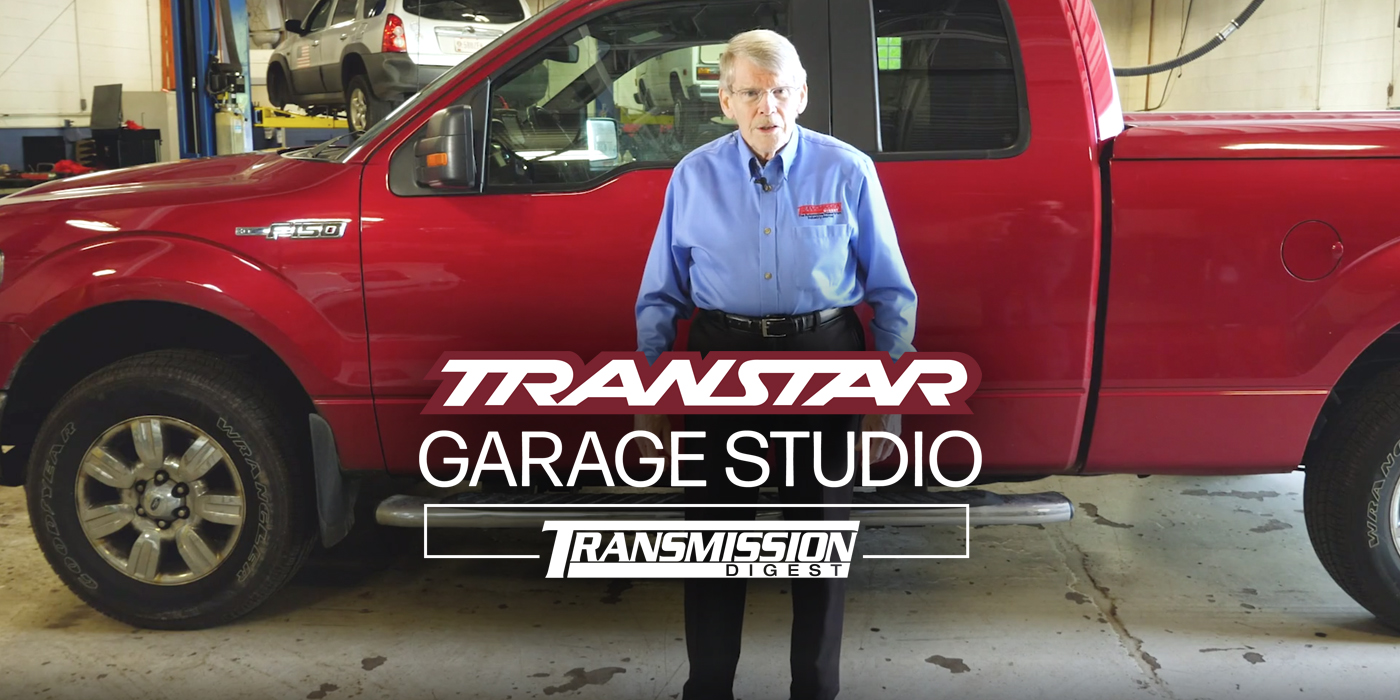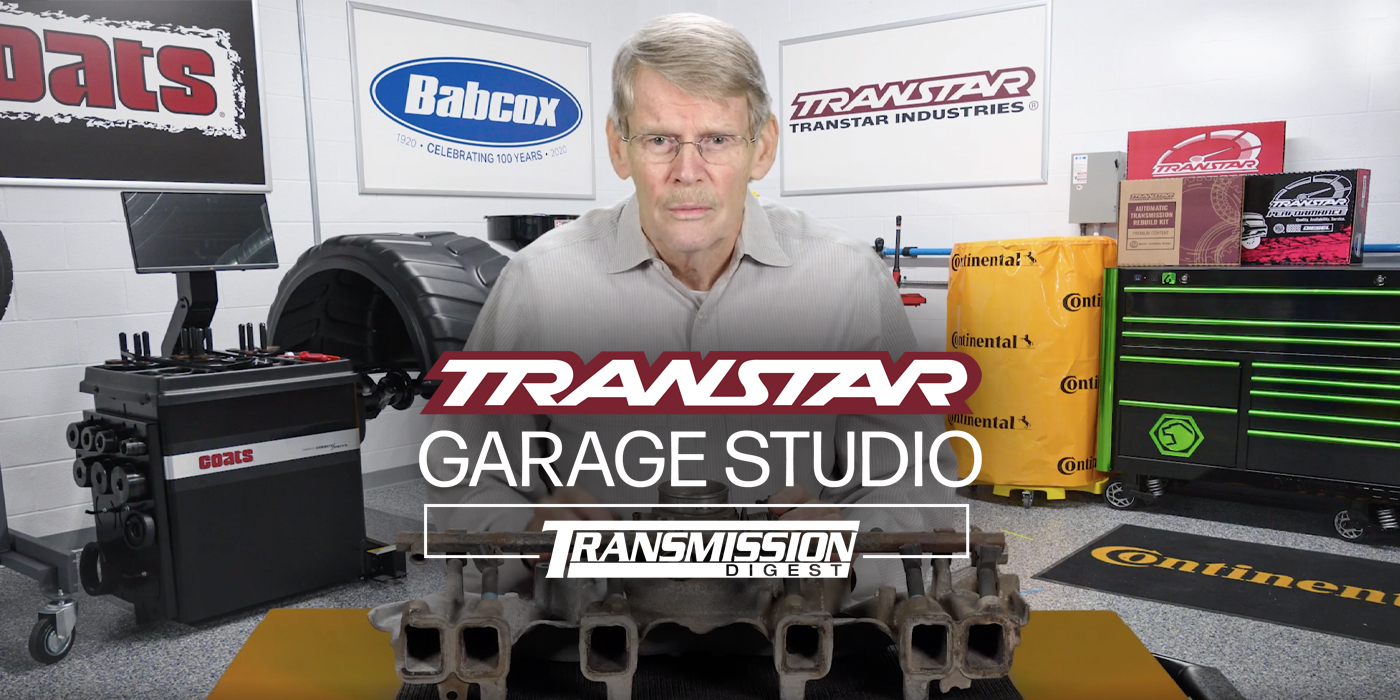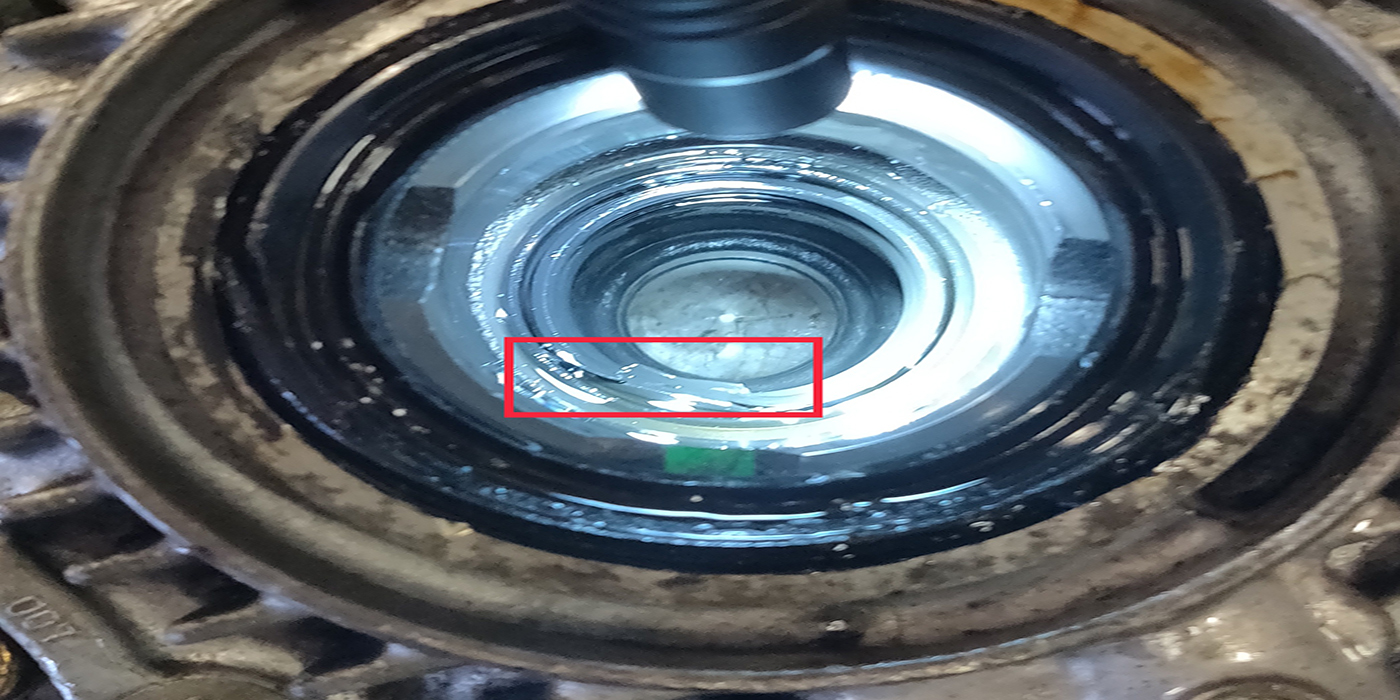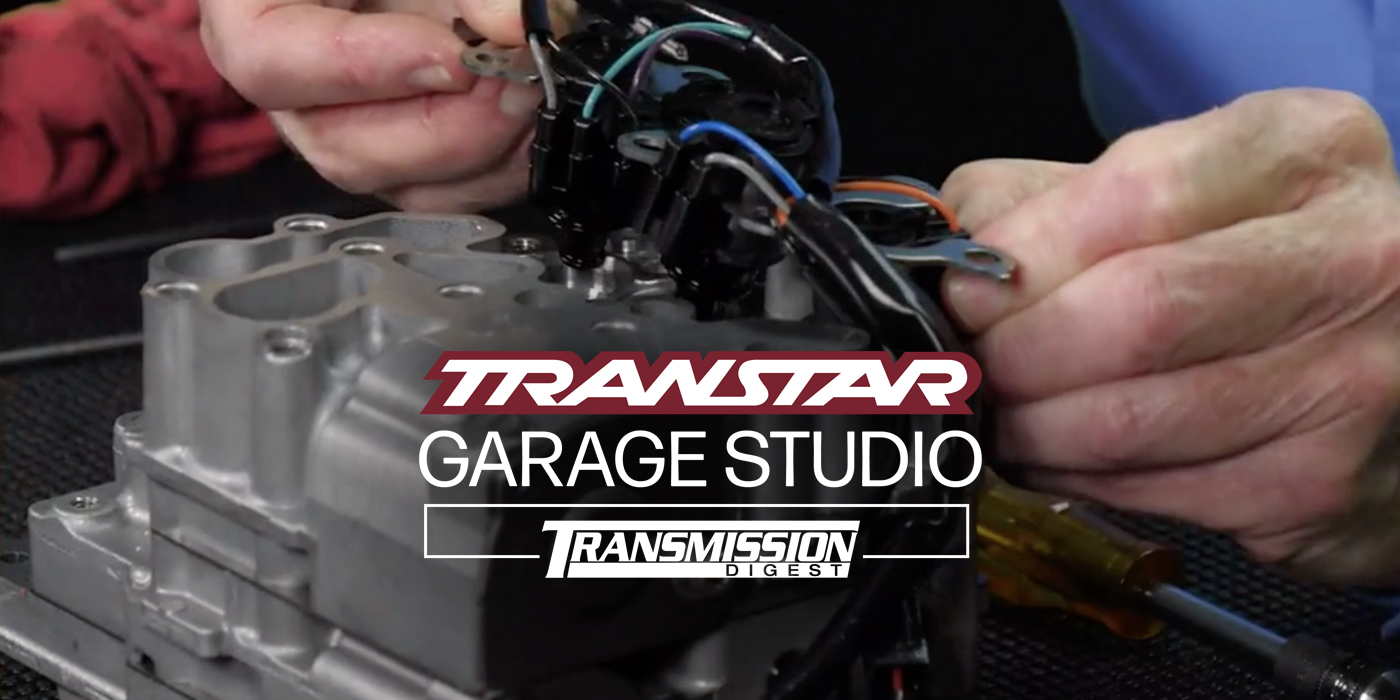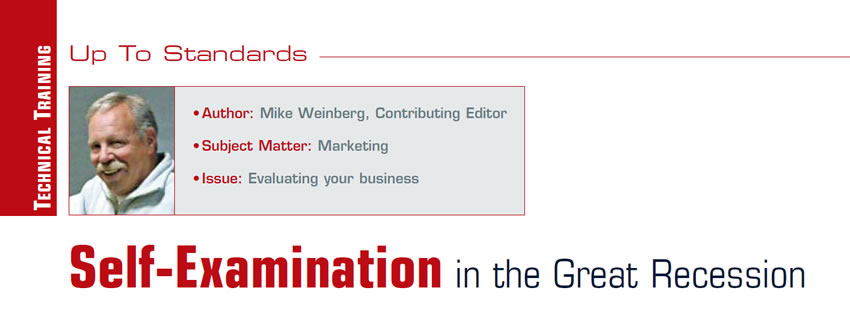
Up to Standards
- Author: Mike Weinberg, Contributing Editor
- Subject Matter: Marketing
- Issue: Evaluating your business
The world is in the midst of a great recession, which has no end in sight. The press and the government will tell you that it is ending, but the average man will not. Our industry has been in decline for years, predating the major economic downturn.
Many factors have reduced the number of vehicles we have to work on, resulting in a two-thirds reduction in the number of dedicated transmission shops nationally. The automakers have created lower leasing costs and longer vehicle warranties, which keep a large number of vehicles from needing our services. Government programs such as “Cash for Clunkers,” which was basically a gift to the automakers, removed about 750,000 vehicles from the market that we deal with. The improvements in manufacturing quality and design have produced vehicles across the spectrum that last longer and require less service.
The dealerships have become very competitive in providing service and work hard at retaining service customers. Through Bluetooth and other electronic media the cars will now actually make service appointments for the customer at required intervals and promote special deals. The manufacturers have also created their own remanufactured units at competitive prices to further erode our market share. To understand how deeply they want this business they have now begun to provide “free” preventive maintenance, oil changes, tire rotations etc. for the customer. All this is not free but built into the purchase price of the vehicle and designed to keep all this work in house.
Another area that is problematic for us is “captive” parts. The carmaker contracts with suppliers to provide it with transmissions, transfer cases, differentials and other components. The carmaker pays for the tooling and prohibits the supplier from selling these parts to the aftermarket.
The cars are built so well today that most major components will last about 150,000 miles or more with proper maintenance, further reducing the traffic to your shop. The “junkyard” has become a salvage or recycling facility, and good used units are now being sold with longer-term warranties and compete for your customer’s business.
This market scenario has created a major change in the transmission- and general-repair-shop operating strategies. General-repair shops now have access to a wide range of remanufactured units and are selling and installing them rather than referring that business to a transmission shop. Trans shops are doing general repairs to keep their bays busy and maintain cash flow, so the specialization that was once well defined has now become a blend of services to the customer.
To survive in this market the trans shop must create a business plan that will work in this ultra-competitive market. The start of any business plan requires an in-depth study of current shop operations and the existing market for its location. This starts with looking in the mirror and being honest with discovering your strengths and weaknesses. Are you running your business or is the business running you?

The first sign of “burnout” in our business is the loss of love for what you do every day. If you have these feelings, your shop is running you. You need to realize where your weaknesses are and make adjustments to correct them. Make a goal of where you wish to be and then take the necessary steps to get there. Are you a leader who inspires employee loyalty and improved production, or are you spending most of your time with a whip in your hand?
Do you have a written manual of standard operating procedures that you provide to your staff so that everyone is on the same page regarding the policies and procedures that you expect them to follow? To empower your people and encourage them to grow in value to the business, everyone must understand your goals and expectations. Change is continuous in the technology, and we must adapt and learn. You must program your people with a path to make this possible so that everyone has an understanding of where you intend them and the business to go.
Customer relations are built and earned. In this market it is more difficult to attract new customers from a limited supply, so the first order of business is to retain the customers you have. You must create the relationship with each customer to promote understanding in the repair process of what their costs and benefits are and to make them want to do business with you. Trust is never given; it must be earned, and that process takes time. You need to make each customer feel that they are important to you in more than just dollars. Doing so promotes faith in your company, and the customer in turn will promote your business by word of mouth.
There will always be problems, and the most-important reflection on you and your staff is how you deal with them and resolve the issues to the customer’s satisfaction. Put procedures in place to inspect every aspect of the vehicle when it comes to you. Identifying every issue on the vehicle that you can provide service for 100% of the time will show the customer that you are concerned for their safety and enjoyment of the vehicle and at the same time give you a way to increase your average repair-order dollar amount. This is the first step to making more money and is value added for the customer. People want to know what to expect and would prefer to have all the work they can afford done in one place, at a fair price.
Is your business profitable? The more limited your customer base the more important it is to maximize every opportunity. How do you set a labor rate? Is it based on reality or a figure based on what the guy across town is charging? You need to break down your overhead costs and the available work capacity of your staff and facility and then calculate a markup to get you to about a 70% gross profit on labor.
The same thing will apply to parts sales. Few people understand the relationship of markup to margin. Markup is the percentage you add to a part to get a desired gross-profit margin. There are charts and formulas to arrive at this, but if you wish to make a 50% margin, you need to mark up a part by 100%. That is not a typo; 100% added to cost (markup) is 50% profit on the selling price (gross-profit margin). If you buy a part from the dealer and the dealer’s published list price is 25% more, charging that price will give you a gross-profit margin of 20%.
By law, the manufacturer’s list price is only a suggestion. You cannot achieve your overhead and desired profit by using that formula. You are adding value by getting the correct part, taking the time to order it and extending the customer a short-term loan by paying for it. Without your time and expertise the customer would have to take time off from work, pick the part out of a complex catalog, pay for it and then bring it to you.
Quality of parts and workmanship is a must to keep the trust of the customer and provide the best possible unit to minimize comebacks and warranty costs. Parts prices are escalating all the time, and it is tempting to buy the cheapest you can. Buy the best quality available at the cheapest price, not just the cheapest parts. In life there is no free ride and very few real bargains. What is the outcome for choosing price over quality? You have only one chance to sell all the parts the customer needs at the proper markup, and if price is your only measure you will have increased comebacks and a failing reputation. Sell what you would want in your own car, not the cheapest, because the increased margins on the cheap parts will have a downside in the future that will negate all profits from the job.

Car manufacturers’ warranty periods have increased greatly. It is difficult to compete with them by offering a longer matching warranty on your product unless you commit to certain procedures. For instance, your standard warranty on a transmission is one year and unlimited mileage and you wish to also offer a 36-month warranty for $400 more. You must be able to build a quality unit that is subject to the same specifications and testing that the manufacturer can provide, and you have to put the $400 into a warranty fund. You cannot live off that money, so treat it as if it is sales tax. By putting the additional money into a separate account, you build up a fund to cover the costs of potential comebacks. When you do have a comeback, you now have a fund to draw from to cover the increased costs of the longer warranty.
Another issue is to place responsibility on the customer to “maintain” the warranty during its life span. You need to have the customer return every six months for a no-charge warranty inspection. This binds the customer to the shop, lets you look at the vehicle and probably sell additional work, and makes sure the fluid levels are correct. You can require and specify fluid changes during the life of the warranty to further expand your profits. Extended warranties commonly demand that the customer produce records of required services to maintain coverage.
Now that you have worked to get your staff up to speed and achieve a percentage of gross profit for a return on investment, you can look to promote growth. Start with a careful assessment of your market. Markets can be broken down into three rough categories: urban (big city), suburban (near big cities) and rural. Urban markets usually do not produce much high-mileage usage but have many more commercial customers. Suburban markets also have lower mileage because of the ride-and-drive commuter parking lots but may generate more miles from pleasure travel. Rural markets average the highest mileage because of longer distances and generally have customers who will maintain cars better for fear of getting stuck 30 miles from home.
Are there enough vehicles in your market to produce growth through the proper advertising campaigns? Finding the demographics in your area using government resources and census counts can lead you to find potential niche markets. Once you have a rough estimate of the vehicles in your market you can begin to evaluate how many times they will visit a repair shop annually. Historically it’s 1.5 to three times a year. If there are 50,000 cars and trucks in your market area, they should generate up to 150,000 visits to repair facilities each year.
You can then generate an idea of the dollar amount for all repairs by visiting your competitors, including car dealers, and counting service bays. If the industry standard is $250,000 a year per bay, you can estimate the total yearly dollar amount for all repairs in your market. Note the services your competitors provide and figure out how you stack up in services provided, price, efficiency and quality. Then you can determine which services you can provide that are not offered and concentrate on the niches that are not being served.
Marketing is a subject for another whole article, if not a book. With the advent of social media, pay-per-click Internet deals and the ability to track where your work is coming from, you can build a plan to acquire new business and make sure the advertising money is well spent. For instance, coupon deals and some print media will provide only customers who want cheap deals, and these may not be the people you want tying up your lifts. It is your business, and the customers will not just appear when you want them. You need to really understand your current business, the capacity of your market and your competition before you can make a workable business plan. Those who sit back and wait for the phone to ring will only see a steady decline. Those who invest the time, knowledge and money will survive and prosper in a tough market.

Mike Weinberg is president of Rockland Standard Gear.










